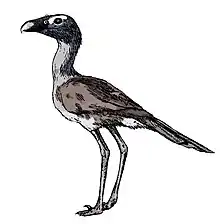| Llallawavis | |
|---|---|
 | |
| Reconstructed skeleton | |
| Scientific classification | |
| Domain: | Eukaryota |
| Kingdom: | Animalia |
| Phylum: | Chordata |
| Class: | Aves |
| Order: | Cariamiformes |
| Family: | †Phorusrhacidae |
| Genus: | †Llallawavis Degrange et al., 2015[1] |
| Species: | †L. scagliai |
| Binomial name | |
| †Llallawavis scagliai Degrange et al., 2015[1] | |
Llallawavis scagliai (magnificent bird of Scaglia) is a large, extinct predatory bird from Pliocene Argentina. Its fossil is the most complete fossil of a phorusrhacid (or "terror bird") yet found.
Description

The fossil, discovered in 2010 in sediment among the cliffs above La Estafeta beach in the lower part of the Playa Los Lobos Allo Formation of around 3.5 million years ago to the Late Pliocene. The terror bird is known from a nearly intact skeleton, including the complete palate, complete trachea, skull, voice box, and eye bones. L. scagliai was a medium-sized phorusrhacid around 1.2 metres (3.9 ft) tall and weighed around 18 kilograms (40 lb). lived in Argentina approximately 3.5 million years ago during the Pliocene.[1]
Paleobiology
Llallawavis scagliai likely roamed in grassland environments, much like the rest of its Mesembriornithine kin.[2] CT scans of its inner ear show that it could only hear frequencies between about 380 and 4230 hertz, and probably had a deep voice to match.[3] These same CT scans also show that the inner ear of Llallawavis is fine tuned to sudden changes in movement, likely from quickly turning when trying to catch prey. Such adaptations are seen in other predators that hunt in open habitats that need to chase fast and agile prey.
This is corroborated by studies of a close relative of Llallawavis, the larger Mesembriornis, whose limb bones have been found to show various adaptations towards high-speed pursuit of prey, with estimates suggesting a top speed of 27 m/s (97 km/h),[4] though somewhat slower speeds have been suggested as more plausible. Additionally, the limb bone's ability to withstand high stresses in addition to the presence of laterally compressed claws on the feet of most terror birds would suggest the usage of the limbs in prey capture as well.[5][6] The joints separating the skulls bones were fused, unlike modern birds, and that may have helped it dispatch decently-large prey animals thanks to the more stress-resistant skull. The skull was likely employed especially once prey was knocked to the ground, with the terror bird pinning it with the use of its strong legs and recurved talons while tearing into prey animal with a powerful beak. Combined, this paints mesembriornithines such as Llallawavis as high-speed pursuit predators chasing small notoungulates across open plains in a manner similar to that of a cheetah, in contrast with their much larger, more robust phorusrhacines (ambush predators of more wooded areas that hunted the larger notoungulates, glyptodonts, and ground sloths).
Phylogeny
The below cladogram is simplified after the analysis of Degrange et al. (2015).[1]
| Cariamiformes |
| |||||||||||||||||||||||||||||||||||||||||||||||||||||||||||||||||||||||||||||||||||||||||||||
References
- 1 2 3 4 Degrange, Federico J.; Tambussi, Claudia P.; Taglioretti, Matías L.; Dondas, Alejandro; Scaglia, Fernando (20 March 2015). "A new Mesembriornithinae (Aves, Phorusrhacidae) provides new insights into the phylogeny and sensory capabilities of terror birds". Journal of Vertebrate Paleontology. 35 (2): e912656. doi:10.1080/02724634.2014.912656. hdl:11336/38650.
- ↑ Perkins, Sid (9 April 2015). "New species of 'terror bird' discovered". Science. doi:10.1126/science.aab2465. Retrieved 2015-04-14.
- ↑ Webb, Jonathan (10 April 2015). "'Terror birds' had deep voices, fossil suggests". Science & Environment. BBC. Retrieved 2015-04-14.
- ↑ Blanco, R. Ernesto; Jones, Washington W (2005-09-07). "Terror birds on the run: a mechanical model to estimate its maximum running speed". Proceedings of the Royal Society B: Biological Sciences. 272 (1574): 1769–1773. doi:10.1098/rspb.2005.3133. PMC 1559870. PMID 16096087.
- ↑ Jones, Washington W. (2010). Nuevos aportes sobre la paleobiología de los fororrácidos (Aves: Phorusrhacidae) basados en el análisis de estructuras biológicas [New contributions on the paleobiology of phororrhacids (Aves: Phorusrhacidae) based on the analysis of biological structures] (PDF) (PhD thesis) (in Spanish). Uruguay: Universidad de la República - Facultad de Ciencias.
- ↑ Kraglievich, L. (1932). Una gigantesca ave fósil del Uruguay, Devincenzia gallinali n. gen. n. sp., tipo de una nueva familia, Devincenziidae, del Orden Stereornithes. In Anales del Museo Historia Natural de Montevideo (Vol. 3, pp. 323-55).
_white_background.jpg.webp)

